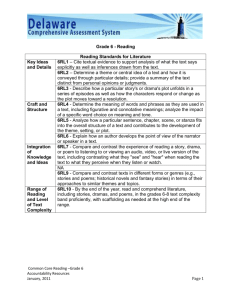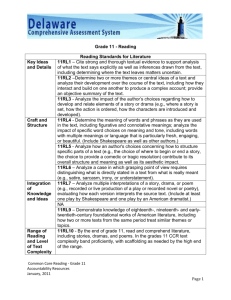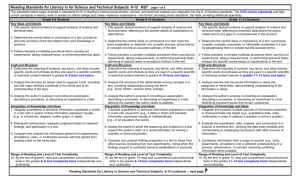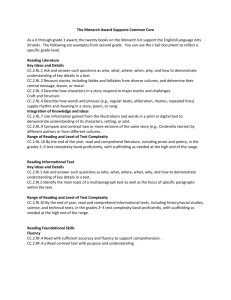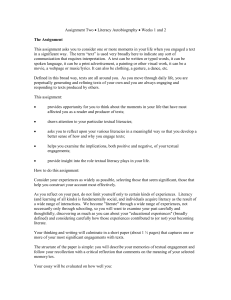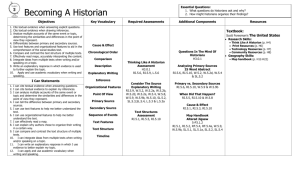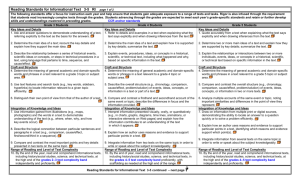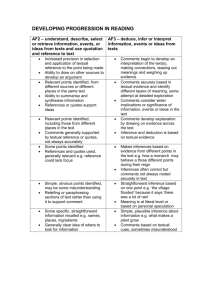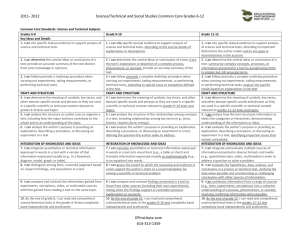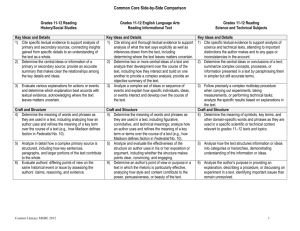6-12 - Erlanger-Elsmere Schools
advertisement
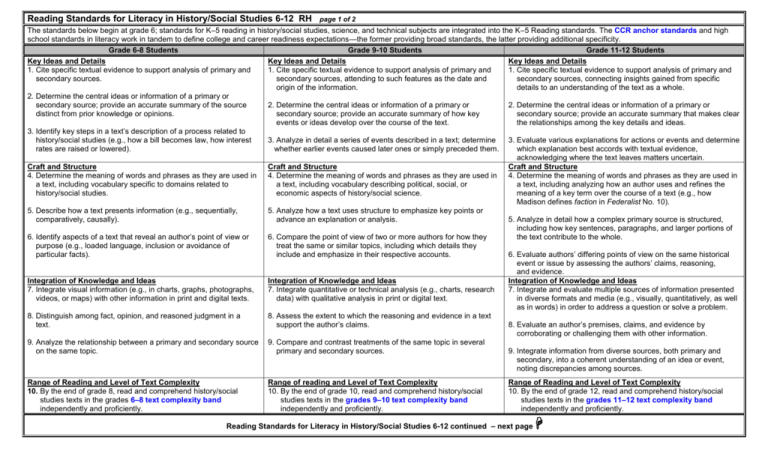
Reading Standards for Literacy in History/Social Studies 6-12 RH page 1 of 2 The standards below begin at grade 6; standards for K–5 reading in history/social studies, science, and technical subjects are integrated into the K–5 Reading standards. The CCR anchor standards and high school standards in literacy work in tandem to define college and career readiness expectations—the former providing broad standards, the latter providing additional specificity. Grade 6-8 Students Grade 9-10 Students Grade 11-12 Students Key Ideas and Details Key Ideas and Details Key Ideas and Details 1. Cite specific textual evidence to support analysis of primary and 1. Cite specific textual evidence to support analysis of primary and 1. Cite specific textual evidence to support analysis of primary and secondary sources. secondary sources, attending to such features as the date and secondary sources, connecting insights gained from specific origin of the information. details to an understanding of the text as a whole. 2. Determine the central ideas or information of a primary or secondary source; provide an accurate summary of the source 2. Determine the central ideas or information of a primary or 2. Determine the central ideas or information of a primary or distinct from prior knowledge or opinions. secondary source; provide an accurate summary of how key secondary source; provide an accurate summary that makes clear events or ideas develop over the course of the text. the relationships among the key details and ideas. 3. Identify key steps in a text’s description of a process related to history/social studies (e.g., how a bill becomes law, how interest 3. Analyze in detail a series of events described in a text; determine 3. Evaluate various explanations for actions or events and determine rates are raised or lowered). whether earlier events caused later ones or simply preceded them. which explanation best accords with textual evidence, acknowledging where the text leaves matters uncertain. Craft and Structure Craft and Structure Craft and Structure 4. Determine the meaning of words and phrases as they are used in 4. Determine the meaning of words and phrases as they are used in 4. Determine the meaning of words and phrases as they are used in a text, including vocabulary specific to domains related to a text, including vocabulary describing political, social, or a text, including analyzing how an author uses and refines the history/social studies. economic aspects of history/social science. meaning of a key term over the course of a text (e.g., how Madison defines faction in Federalist No. 10). 5. Describe how a text presents information (e.g., sequentially, 5. Analyze how a text uses structure to emphasize key points or comparatively, causally). advance an explanation or analysis. 5. Analyze in detail how a complex primary source is structured, including how key sentences, paragraphs, and larger portions of 6. Identify aspects of a text that reveal an author’s point of view or 6. Compare the point of view of two or more authors for how they the text contribute to the whole. purpose (e.g., loaded language, inclusion or avoidance of treat the same or similar topics, including which details they particular facts). include and emphasize in their respective accounts. 6. Evaluate authors’ differing points of view on the same historical event or issue by assessing the authors’ claims, reasoning, and evidence. Integration of Knowledge and Ideas Integration of Knowledge and Ideas Integration of Knowledge and Ideas 7. Integrate visual information (e.g., in charts, graphs, photographs, 7. Integrate quantitative or technical analysis (e.g., charts, research 7. Integrate and evaluate multiple sources of information presented videos, or maps) with other information in print and digital texts. data) with qualitative analysis in print or digital text. in diverse formats and media (e.g., visually, quantitatively, as well as in words) in order to address a question or solve a problem. 8. Distinguish among fact, opinion, and reasoned judgment in a 8. Assess the extent to which the reasoning and evidence in a text text. support the author’s claims. 8. Evaluate an author’s premises, claims, and evidence by corroborating or challenging them with other information. 9. Analyze the relationship between a primary and secondary source 9. Compare and contrast treatments of the same topic in several on the same topic. primary and secondary sources. 9. Integrate information from diverse sources, both primary and secondary, into a coherent understanding of an idea or event, noting discrepancies among sources. Range of Reading and Level of Text Complexity 10. By the end of grade 8, read and comprehend history/social studies texts in the grades 6–8 text complexity band independently and proficiently. Range of reading and Level of Text Complexity 10. By the end of grade 10, read and comprehend history/social studies texts in the grades 9–10 text complexity band independently and proficiently. Range of Reading and Level of Text Complexity 10. By the end of grade 12, read and comprehend history/social studies texts in the grades 11–12 text complexity band independently and proficiently. Reading Standards for Literacy in History/Social Studies 6-12 continued – next page Reading Standards for Literacy in History/Social Studies 6-12 RH DOK 1 Depth of Knowledge DOK 2 DOK 3 DOK 4 page 2 of 2 Program of Studies Transformations MG 1.2 2.24 2.25 Communication Skills 1.3 1.4 1.12 Problem Solving Skills 5.1 5.2 5.3 5.4 5.5 Con. & Integrating Knowledge 6.1 6.2 6.3 Reading HS 1.2 2.24 2.25 1.3 1.4 1.12 5.1 5.2 5.3 5.4 5.5 6.1 6.2 6.3 Resources Bloom’s Taxonomy Bloom’s & William’s Taxonomy CPE’s NAEP Distributions in Reading & Writing Core Standards Glossary WEB Resources Kentucky Department of Education US Department of Education Core Standards International Reading Association National Council of Teachers of English Lexiles
